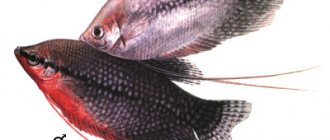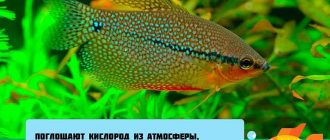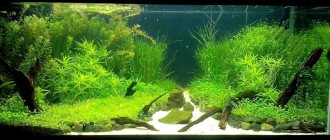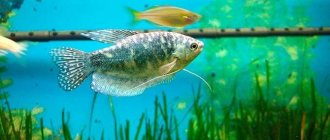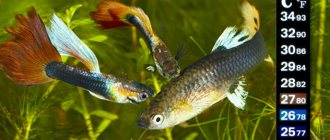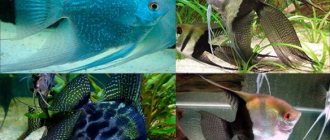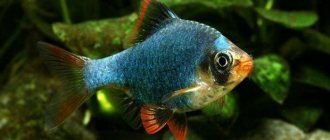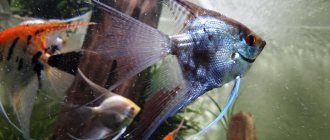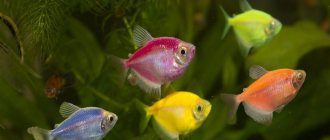History of gourami
The French scientist Pierre Carbonnier dreamed of acclimatizing very interesting fish discovered in the tropics in France. Among them were wide, forehead-shaped fish, constantly rising to the surface of the water and sticking out the tip of their muzzle - gourami. However, they did not manage to get to Europe right away. They were caught in Thailand, Vietnam, and the islands of Malaysia, but the fish did not survive the journey even for a day and died. In those days, transportation of exotic fish was carried out in wooden barrels filled to the top with water. During the voyage, the steamer often experienced rocking, and to prevent the water from the barrel, and with it the fish, from flying overboard, a wooden circle was lowered onto the surface of the water in the barrel, so that it completely covered the surface. Few people knew about the characteristics of labyrinth fish, although at that time in Paris Carbonnier studied and successfully bred the macropod. Without access to atmospheric air, the poor fish lived only until the barrels were loaded onto the ship. After many unsuccessful attempts, they were classified as problematic and their distribution stopped for twenty years.
Eyewitnesses were perplexed: in nature, gourami were caught in rain barrels, gutters, abandoned quarries with incredibly dirty and muddy water - what did the fish lack during transportation?! Only at the very end of the 19th century, a certain sharp-witted European, observing capricious creatures in a natural body of water, noticed that fish periodically rose to the surface of the water for an air bubble. On the advice of his Indonesian guide, he filled the transport containers only two-thirds with water and did not seal them. As a result, several thousand displaced people were delivered to their destination without a single loss.
Gourami appeared in amateur aquariums abroad only in January 1896, but it came to us only in the summer of 1897 and, moreover, from two sources at once: from Matte from Berlin and from V.M. Desnitsky, who brought it directly from Singapore.
Origin story
For such an interesting phenotype as gourami, the fish’s homeland is in the tropical waters of Thailand, Vietnam and Malaysia, where agile and bright representatives of the genus calmly survived in the most unsuitable conditions:
- Rain barrels.
- Rice fields.
- Ditches and pits filled with rainwater.
Having become interested in tenacious fish, people tried to transport captured representatives to other countries, but failed. Hardy and unassuming phenotypes died on the road, so the fish were left alone. And only a couple of decades later, researchers and aquarium enthusiasts found out the cause of death of the individuals - the fish died due to lack of air. At that time, humanity did not yet know about the special structure of labyrinth fish, so shipping containers were filled with water to the brim and closed tightly, and the poor creatures suffocated. The first successful transportation of fish took place in 1896 - in a barrel 2/3 full.
The spread and breeding of gourami as an aquarium resident is closely intertwined with the name of Pierre Carbonnier, who participated in the transportation of fish. The phenotype was brought to Russia by A. S. Meshchersky, a fan of underwater depths and inhabitants. Paul Matte and V.M. Desnitsky also contributed to the history of fish.
Kinds
Gourami is an aquarium fish that is loved by aquarists due to its peacefulness, unpretentiousness and variety of varieties. Types of gourami differ from each other in size and color, and there are a great many of them, but only a few varieties can rightfully be considered popular in the aquarium hobby.
Pearl
The pearl variety is a beautiful fish that has earned a mysterious name for its excellent body color. The color of the scales of pearl representatives is silver, with lilac and violet reflections, the back is lemon-brown, the fins and sides are bluish. There are light dots on the body of the phenotype, like a scattering of pearls. Pearl fish do not exceed 10 cm in length and have a modest and friendly disposition.
Interesting fact: in their homeland, pearl representatives are listed in the Red Book.
Lunar
In the homeland of the moon gourami, fish breeding is carried out in order to prepare dishes or catch them for sale. The body length of moon gourami in an aquarium is 10-12 cm, but in natural habitats the fish grow up to 18 cm.
A distinctive feature of the lunar variety is small scales and red-orange eyes. The body is gray-blue with a clear silver tint. The female moon gourami is more modestly colored than the males of the same species. The lifespan of moonfish at home is 7 years.
Spotted
Due to its undemanding phenotype, keeping and caring for the spotted gourami will not cause any difficulties even for a beginner in the field of aquarium keeping. In a home tank, the length of spotted fish reaches 10-12 cm, the body color is bluish or light sapphire with spots and stripes.
Interesting fact: in the wild, spotted gouramis hunt prey by knocking down insects with a stream of water.
Gold
Golden gourami cannot be found in the wild, since this variety is the result of the efforts of breeders. Representatives of the species are characterized by endurance, mobility, unpretentiousness in matters of nutrition and maintenance, as well as golden color. The body of the fish is golden in color, with dark spots along the back, which makes this species extremely attractive in the eyes of fish holders.
Marble
Marble gouramis are cute and nimble fish, the color of their scales resembles marble stone. Representatives are distinguished by their large body dimensions - up to 15 cm, and are considered among the most aggressive among their relatives. When choosing neighbors for the marbled variety, you should take into account compatibility with other fish.
Grumpy
Grunting fish are an unusual phenotype that has gained fame due to the ability to make a variety of sounds similar to the croaking of baby frogs. The color of the fish is yellowish-lemon, the body is decorated with dark stripes, and the eyes are scarlet or golden-orange. Representatives grow up to 6-8 cm in length. The grumbling variety has calm and friendly phenotypes, despite the fact that the male has spine-like processes adorning the tail.
Honey
The honey variety, or coliza, is an unpretentious fish that has earned the love of aquarists due to its undemanding nature and pleasant color. The phenotype extends up to 6 cm in length, while the females are larger than the male honey gourami, and the colors of representatives of the opposite sexes are also different. The character is shy and timid, and if the fish are stressed, the color of the fish turns pale.
Kissing
The variety received its unusual name due to the strange habit of the fish: when they meet, the pets freeze and then touch their mouths. These actions are very similar to the kiss of a couple in love, which is why the fish got its nickname.
Kissing fish are easy to keep and grow up to 15 cm in length. The colors are gray or pink, the latter option is in great demand. Many aquarists are interested in how long kissing gourami live - life expectancy is 6-8 years.
Homeland of guram fish - habitat
In nature, gouramis live in Southeast Asia (the Indochina and Malay peninsulas, the islands of Kalimantan, Sumatra and Java).
The pearl gourami Trichogaster leeri lives in the Malay Archipelago, Sumatra and Borneo. Moon gourami Trichogaster microlepis is found in Thailand and Cambodia, Snake gourami Trichogaster pectoralis in southern Vietnam, Cambodia and eastern Thailand. The spotted gourami Trichogaster trichopterus has a wide range from India to the Malay Archipelago. In different parts of this range there are many local forms that differ in color. In Sumatra, along with these forms, the blue gourami Trichogaster trichopterus sumatranus lives. The serpentine gourami, its habitat approaches the ocean coast - opposite the island of Sri Lanka, the serpentine gourami did not move to the island itself, but has colonized the water bodies of the Antilles in Central America. Gourami are found in both standing and flowing waters, as well as in small streams and large rivers, and spotted and brown gouramis have mastered the tidal zone and brackish estuarine waters.
Habitat in nature
The true gourami was first described by Lacepède in 1801. Lived in Java, Boreno, Sumatra. But now the range has expanded significantly.
The species is very widespread, both in nature and in artificial reservoirs, and is not under threat. In many countries, including Australia, it is bred as a commercial species. In Asia it is considered an important food source.
The species belongs to the genus Osphronemus, which includes four species. In addition to this, the aquarium also contains a giant red-tailed gourami.
Giant gouramis inhabit flatlands, where they live in large rivers, lakes, and, during the rainy season, in flooded forests.
They are also found in standing water, even in swampy areas.
Sometimes the real thing is found even in brackish water. But all these places are united by rich vegetation and abundance of food.
They feed on small fish, frogs, worms and even carrion, that is, they are omnivores.
Description of gourami
Gourami (Gourami-nite-bearers) are representatives of the genus of tropical freshwater labyrinthine fish of the macropod family (Osphronemidae), whose length ranges from 5 to 12 cm (there is also a larger representative - the serpentine gourami, reaching 20 -25 cm). These wonderful creatures received their name for the presence of elongated thread-like fins on the abdomen, which nature endowed them with for orientation in muddy natural bodies of water.
Like all labyrinth fish, gourami have a labyrinth (epibranchial organ), which arose as a result of adaptation to life in water with low oxygen content. The labyrinthine organ is located in the epibranchial cavity, in the expanded part of the first branchial arch. This cavity contains the thinnest bone plates, covered abundantly with blood vessels and mucous membrane.
Gourami will not be able to live without atmospheric air; in a closed container they will die quite quickly. The labyrinth organ develops only 2 - 3 weeks after the larvae hatch from the eggs, so the fry need oxygenated water. It is believed that the labyrinthine organ serves to enable the fish to move from reservoir to reservoir: the fish collects a supply of water into it, and when it moves from reservoir to reservoir, the gills are moistened, which prevents them from drying out.
It is worth remembering that when transporting fish over long distances, their need for air must be taken into account, otherwise they may die from suffocation. IMPORTANT: When transporting any labyrinth fish, oxygen must not be pumped into the bag; by capturing it with the mouth, the fish “burn” the respiratory organs and die!
The body shape of the fish is elongated, flat, flattened laterally. The dorsal and anal fins of the male are elongated and slightly pointed, while the dorsal fin of the female is much shorter and rounded, the pelvic fins are equal in size to the length of the fish and look like thin mustaches. If for any reason your gourami's whiskers break off, there is no need to worry as they will grow back soon. The color of males is much brighter than females. Bright color is an indicator of the health of the fish.
Gourami - what you didn't know about them yet
What do they get sick with and why?
Unfortunately, fish sometimes get sick. There are organisms that cause various diseases in gourami. In a short time they are able to infect all inhabitants of the reservoir.
Diseases affecting pets:
Lymphocystosis is a serious disease, easily identified by open wounds, grayish nodes or black growths that appear on the body. The skin around the formations rises slightly. Usually, sick fish looks like it has been sprinkled with semolina. People call this disease “semolina”.
pseudomonosis - the disease makes itself felt with darkish spots that quickly turn into red sores. Through them you can “catch” an infection.
aeromonosis - this disease gets to the fish along with food. At first, frail fish in densely populated aquariums get sick. The first sign is that the scales are bristling. Then the fish stop eating, become almost motionless, and lie down on the bottom. Their tummy swells and there are blood stains on it. If your pet is treated, he can make a full recovery.
We recommend reading
Aquarium catfish: types, reproduction, maintenance and care
Conditions for keeping gourami
A comfortable aquarium for gourami is considered to have a capacity of 50 liters or more, preferably larger. Since the fish in its natural habitat lives mainly in stagnant water, the presence of a strong current from the filter in the aquarium is undesirable. Acceptable water temperature is from 23 to 26 degrees; gourami will normally tolerate a temperature drop of up to 20 degrees and an increase of up to 30 degrees. Hardness should not exceed 16. Weekly changes of ~ 1/4 water are required. Aeration of water is not necessary for gourami, but for the aquarium itself, oxidative processes play an important role, without aeration they are difficult, and therefore there must be aeration, at least weakly. It is important! As with any other fish, high concentrations of poisons are unacceptable for gourami: ammonia, nitrites and nitrates . Nitrifying bacteria are aerobic and require oxygen. Every conscientious aquarist should always have a set of drop tests on hand, at least for nitrate and phosphate. Fortunately, they have now become inexpensive, there are no problems with their assortment and acquisition. For example, we can with a clear conscience recommend you the cool UHE drop tests, , but they are sold only online. In stores in your city - offline, you can find inexpensive Vladox tests . Friends, watch out for nitrogen compounds, keep them in check and everything will be fine for you and your pets.
Further, it is worth noting that it is advisable to keep gouramis in dense grass beds, but do not forget about the availability of places for swimming. The combination of dark soil and bright lighting will allow you to get the most saturated color from your pets. The tannins released by driftwood will not only improve the health of the fish, but will also make the water look like water from its natural habitat.
Gourami prefer to swim in the middle and upper layers of water. An aquarium with gourami should be equipped with a lid or cover glass to prevent the fish from jumping out of the aquarium.
Gourami have one peculiarity - they love “old water” with a soft, slightly acidic environment, i.e. with a pH of 6-7 degrees. This is understandable, because their biotope is muddy, silted rice fields, puddles and ditches. And this is the moment we want to chew on for beginners.
When a beginner reads “old water,” he thinks, “Aha, that means you don’t have to change the water in the aquarium with it for a long time.” Even some aquarium websites say: “Guramis love old water. Therefore, do water changes less frequently.”
However, this is not quite true. The meaning of the phrase “old water” is somewhat different. It means a well-ripened biological environment in which all links of the biocenosis work as a single, well-coordinated mechanism. Therefore, on the contrary, you can easily change the water as much as you like. This will not harm the gourami. It’s simply best to keep them right away in an established aquarium, where the nitrogen cycle works like a Swiss clock, where there is a lot of vigorous and varied grass, where the whole bunch and all hydrobionts are happy.
Let’s also say a few words about the concept of “black water”, which gouramis also love. You've all seen biotope aquariums with dark brown water. This is exactly what it is - “black water”. In professional biotope aquariums, this effect is most often achieved naturally - due to the abundance of driftwood and all kinds of foliage in the aquarium. They are the ones who release tannins abundantly into the aquarium, which tint the water.
It is not necessary to shove logs and sticks into an amateur aquarium with gourami. For a beginner, this can only cause problems with the nitrogen cycle. Instead, you can use, for example, a conditioner such as Tetra Thorumin , which is essentially a peat extract. It contains tannins and humic acids, as well as a certain amount of macro and micro elements, and other useful things for both fish and plants.
We would like to draw the attention of beginners that Tetra Torumin ibn peat extract does not have to be used according to the instructions. On the contrary, it is best to use it little by little, as a treat, for example, adding it after a water change. Those. It is not necessary to pour the extract until the stable color of childish surprise. This is due to the fact that peat is a good thing, but it still burdens the ecosystem. It is best used in a stable aquarium, in which everything is super nitrogen-cycled. And if this is the case, then we assure you that the addition of tannins and humins will please your plants, as well as soft-water slaves, which are the heroes of this video - gourami. And also, for example: angelfish, neons, cockerels.
What type of aquarium is needed?
Fish need to create conditions that resemble their natural habitat. An aquarium for 3 or 5 individuals should have a minimum volume of 40 liters. The more fish, the larger the container should be. Pour in warm and not hard water. Temperature is from 24.5 to 28.5 degrees, hardness is 9-20 pH, and acidity is from 6.50 to 7.50 dH.
Select the soil in dark tones, the fraction is not important. Plant more vegetation in your aquarium, but be sure to leave room in the middle for the gourami fish to move around. You can use, for example, cryptocorynes, cirrus, and Thai fern. Plants help fish calm down and have privacy.
We recommend reading
Glass aquarium fish
Also, install a variety of hiding places in the aquarium for swimming fish. Driftwood, stones, clay pots and coconut shells are suitable for this purpose. Place any floating plants on the water, for example, watercolor, riccia, pistia. If there is a lot of algae and hiding places in the aquarium, the fish do not experience stress, because in their homeland they live in muddy, shallow water. They can rest peacefully in thickets of plants.
Gourami compatibility
Gourami are very peaceful and calm fish that can easily make friends with all other peaceful species of fish (botia, lalius, thorns, etc.). However, it is worth remembering that very fast fish species (such as swordtails and barbs) love to chase the gourami's whiskers. When choosing neighbors, you should also remember that gouramis are soft-water and acidic fish, that is, they prefer pH and dH below 7. It is advisable to maintain these comfortable water parameters for the gouramis themselves and select the same soft-water neighbors.
What to feed gourami?
Gourami are completely unpretentious in feeding and are ready to feast on any food they find. Like other fish, gourami will be very grateful for a varied diet. After all, feeding any aquarium fish must be correct - balanced, varied. This fundamental rule is the key to successfully keeping any fish. The standard and well-known TetraMin food is perfect for gourami.
It should be noted that when purchasing any dry food, you should pay attention to the date of its manufacture and shelf life, try not to buy food in bulk, and also store the food in a closed state - this will help to avoid the development of pathogenic flora in it.
Sexual dimorphism - the difference between male and female gourami
Sexual dimorphism in gourami, regardless of the species, can be seen quite clearly - males are larger and slimmer, their coloring is brighter, and their fins are longer. The dorsal fin in males is larger and elongated, in females it is rounded - this is the most reliable sign for determining the sex of gourami.
Breeding and propagation of gourami
Breeding gourami does not require much skill or investment. Let's start with the fact that these fish can be bred both in a general aquarium and in a separate small spawning aquarium of 20 liters with a water column height of 10 to 15 centimeters.
If spawning is carried out in a common aquarium, then the main condition will be the presence of floating plants on the surface (riccia, hornwort, duckweed and others) and the absence of a strong current, so as not to destroy the foam nest created by the male.
If spawning is carried out in a spawning aquarium, then you need the water to have the following parameters: water temperature 24 - 26 C, hardness 4 - 10, acidity 5.8 - 6.8. Plants should float on the surface, and at the bottom there should be shelter for the female. Next, we add a male to the spawning aquarium we have allocated. We feed the pair generously, preferably with live food, for a couple of 1 - 2 weeks. Just before spawning, we transplant the female into the spawning aquarium. And we watch the couple’s very exciting games. Gourami change their color to a brighter one and swim with their fins spread. The male, like a caring father, constantly maintains the foam nest in an intact state, which he builds from air bubbles released from the mouth along with saliva. It takes the male about 3 days to build a foam nest. There is no need to worry if during this period the male does not show interest in food and only huddles near his building. And when the nest is completely built, gourami spawning begins. The male tries in every possible way to drive the female under his nest, and having driven it, he begins to squeeze the female and fertilize the game, which easily floats to the surface of the aquarium water. The spawning period usually takes place in 3 - 4 hours, in several passes. To speed up the spawning process, you can add 1/3 of the volume of the spawning aquarium with distilled water and raise the temperature to 30 C.
Usually the female lays about 200 eggs, maybe more. At the end of spawning, the fish rush in different directions: the female goes to the shelter, and the male to the nest, where he will care for the eggs until the fry hatch. But the female must be removed immediately so that she is not attacked by the male, or damages the nest by eating the eggs of an inexperienced father. The incubation period for gourami eggs is 24 to 48 hours. The development of eggs directly depends on the temperature of the water in the aquarium.
After 2 - 3 days, the larvae enter the fry stage and begin to swim. The male is on the alert here too, he collects the fry with his mouth and carries them to the nest. As soon as all the fry hatch and begin to swim around the spawning aquarium, we also catch the male so that he does not eat his offspring. The male is not fed during the entire period of courtship for the offspring. When larvae appear, it is necessary to reduce the water level to 6-10 cm and maintain it until the fry have formed a labyrinthine apparatus, which requires at least a month. If there are a lot of larvae, then it is necessary to provide weak aeration in the spawning aquarium.
The fry are often fed generously, but in micro portions, with ciliates, fine “dust,” and special foods, for example, TetraMin Baby.
The main thing is to ensure that the food is fully consumed by the fry, and remove the excess in a timely manner. Gourami fry grow unevenly; the larger and more developed ones begin to compete with the small ones and can eat them. Here it’s up to you to either constantly sort the fry into groups, or let everything take its course.
Peculiarities of breeding: first, the formation of a pair for spawning should occur naturally, based on observation of grown-up fish living in a school; second, young fish spawn well at the age of 8 months to 1 year; if you miss this period, you may not have any offspring at all; third, gourami love clean water, therefore the water in the spawning aquarium should be clear; fourth - during spawning it is better to provide the fish with complete rest and cover the front side of the spawning aquarium (with a towel, cardboard, paper, etc.); fifth - sometimes gourami in an aquarium are able to spawn without a nest. In this case, the eggs spread across the surface of the water and the fry hatch from them just as successfully.
Gourami species
Today, in home aquariums you can find a large number of varieties of gourami: pearl, blue, marbled, golden, kissing, moon, honey, spotted, grunting and others.
But in fact, there are only four species of the named gourami - the genus Trichogaster:
— Pearl gourami (Trichogaster leeri).
— Moon gourami (Trichogaster microlepis).
— Brown gourami (Trichogaster pectoralis) is the largest of the genus Trichogater. In an aquarium it can reach 15 centimeters in length; in nature it grows even larger. However, despite its size, it is a peaceful fish.
— Spotted gourami (Trichogaster trichopterus). The last species has many different color variations - morph: blue, yellow and white. These morphs bring some confusion to the gradation of gourami - trichogasters.
All trichogasters are close relatives of the giant game fish called gourami in Indonesia - Osphromenus goramy. By the way, they are now also keeping it in aquariums.
For their resemblance to this fish, all of its more or less large relatives with thread-like pectoral fins also began to be called “gourami” by tradition. In Javanese, "gurami" means "fish showing its nose out of the water."
A genuine gourami grows up to 1 meter. In Indonesia and Malaysia they are sold in grocery stores. And the hamsters eat them like we cutlets with hake.
In addition, it is worth noting separately that kissing gourami is not a genus of Trichogaster at all, it is a genus of Helostoma. The honey gourami itself is the genus Colisa, the grumbling gourami is the genus Trichopsis, the chocolate gourami is the genus Sphaerichthys. But all of them in the post-Soviet space are popularly called GURAMS. And also, the constant reclassification of fish adds fuel to the fire. For example, today Trichogasters are classified into Trichopodus; some biologists retain the previous nomenclature, while others use a new one. This has not yet been fully legalized. Both options are still used in parallel today. You can write it either way. However, according to the new nomenclature, all Trichogasters are now Trichopodus, and all Colyses are now Trichogasters. Below are the most popular species, morphs and false gourami.
Pearl gourami
Trichogaster leeri
The body of the pearl gourami is tall, elongated, flattened laterally. The body color is silver-violet with numerous pearlescent spots (resembling pearls), scattered not only throughout the body, but also on the fins. An uneven dark stripe runs along the entire body. The length of the pearl gourami is 11 centimeters.
The male is much larger than the female, has a brighter color, elongated dorsal and anal fins. However, there is another, very characteristic feature - the color of the neck of pearl gourami: red in the male and orange in the female. These differences appear already at a young age, but are especially pronounced in older individuals. And during the spawning period, the male’s color differences prevail: the neck and abdomen light up with a red tint, the pearls shimmer and sparkle. Therefore, identifying the sex of fish does not cause difficulties at any age.
Pearl gouramis do not tolerate transplants and “moving” to a new place well - they remain shy and pale in color for a long time.
In nature, pearl gourami lives in the reservoirs of India and Indochina, in the south of Malaysia and Thailand. In reservoirs carrying well-heated, clean water with rich, dense vegetation.
Moon gourami
Trichogaster microlepis
Currently they inhabit the rich vegetation reservoirs of Cambodia and Thailand. They were brought to Europe in 1951, and in 1981 they began to appear among aquarists in Russia.
The fish has a tall body, slightly elongated in length and compressed at the sides. The body is painted in a uniform bluish-silver color. In aquariums they usually do not exceed 12 cm, but in the wild they can reach 15 cm. Life expectancy is from 5 to 7 years.
The fish are peaceful and shy. They can be kept with almost all peaceful inhabitants of the aquarium. But it is advisable to select fish of similar size for their neighbors.
For comfortable living, the aquarium must be at least 50 cm in length, planted in places, have shelters and free space for swimming. In addition, the aquarium should have floating plants that the fish use for spawning. To highlight the beauty of this fish, it is better to use dark-colored primers.
Blue gourami
Trichogaster trichopterus sumatranus
In nature, it lives in Southeast Asia, in the waters of the island of Sumatra. It first appeared in Europe in 1958.
The blue gourami has a tall, oblong and laterally flattened body. The upper fin is high and pointed. The lower fin starts from the pectoral fin and gradually expands to end at the base of the tail. The pectoral fins have the shape of thread-like antennae. They are the gourami's sense organs and are constantly in motion. With the help of pectoral fins, fish become familiar with surrounding objects. The main body color is sea green. On the sides there are transverse blue stripes and two black spots on each side: one in the center of the body, the second on the caudal peduncle. The unpaired fins are decorated with silvery dots scattered on them. In nature, blue gourami reaches 12-14 cm in length; in an aquarium they grow up to 8-10 cm.
The blue gourami is very peaceful and gets along well with various types of fish of large and small sizes, but sometimes there are individuals that show aggression towards their relatives. Leads a daily lifestyle. It lives in the middle and upper layers of water. These fish are very interesting to watch: they are cheerful and do not miss a moment to frolic, they are curious about everything new, be it an element of decor or another fish.
Marbled gourami
Trichogaster trichopterus sumatranus
The marbled gourami is a mutation of the blue gourami. Large fish. Individuals of the marbled gourami species can reach 13 cm in length. The body is oval, high, laterally compressed. The pelvic fins are long and filamentous. The anal fin is wide. The body color is marbled: there are dark gray spots of irregular shape on a light gray background. The anal, dorsal and caudal fin are dark gray, with numerous yellow spots. The pectoral fins are transparent and colorless. The male differs from the female in having a narrower body, bright coloring with elongated, more pointed dorsal and anal fins. It is best kept in an aquarium with a volume of 50 liters+.
Golden gourami
Trichogaster trichopterus sumatranus var. Gold
In nature, it lives in reservoirs rich in vegetation on the island of Sumatra.
The golden gourami has a tall, slightly elongated and laterally compressed body. The body of the gourami is golden yellow with an orange tint. There are two dark spots on the side, one in the middle of the body, the other on the caudal peduncle. Blue spots are scattered throughout the body and fins. The male is larger and brighter than the female. It grows up to 13 cm in length. The lifespan of a fish in an aquarium with proper maintenance is up to 7 years.
The golden gourami is a peaceful, shy fish that, in case of danger, prefers to hide in dense thickets. It gets along well with various types of fish of large and small sizes, but sometimes males show aggression towards each other. They lead a diurnal lifestyle. Golden gourami stays in the upper and middle layers of water.
It is necessary to keep a golden gourami in a well-lit aquarium with a volume of at least 100 liters (for 4 fish) with thickets of living plants (including floating ones) and free space for swimming. It is desirable to have snags (the fish constantly stay near them), the soil is dark.
Gourami kissing
Helostoma temminckii
Kissing gourami inhabit Thailand and the islands of Kalimantan, Sumatra and Java. In nature, gourami lives in water bodies of India and Indochina.
The popular name of the fish “kissing” is associated with the characteristic “kissing” movements of the lips that fish make when feeding, showing aggression, and also during courtship.
The dorsal and anal fins are long and low. The fins have a greenish and sometimes yellowish tint. The color of the kissing gourami varies: gray-green, golden-pink, and yellow. There are albinos.
He is distinguished by a calm and peaceful character, a little timid. Gets along easily with non-aggressive neighbors. However, if there is not enough space, the fish can fight for territory, opening their mouths wide.
Kissing gourami can be kept in an aquarium with a capacity of at least 50 liters with densely planted vegetation; it is also necessary to have driftwood as a shelter and a free swimming area. The soil should be dark.
A few more words about livability
Compatibility is possible with small fish that will swim at the bottom of the aquarium. Sometimes gourami get along better with other aquatic inhabitants than with close relatives. Normal compatibility with zebrafish, iris, neon, as well as swordtails, minors, cichlids and angelfish. Different types of gourami live well in one aquarium.
We recommend reading
Which aquarium fish are the most unpretentious?
They should not be kept together with large predators, as well as very active and playful aquatic inhabitants. There are also those that pluck the fins of gourami or constantly lift them up: cockerels, parrot fish, goldfish.
Gouramis are definitely incompatible with discus fish, koi carps, and guppies.
Chocolate gourami
Sphaerichthys osphromenoides
Chocolate gouramis are found in Indonesia (Sumatra, Borneo) and Malaysia.
The body of chocolate gourami has a red-brown or chocolate color, with a slight greenish tint. The entire body is crossed by several light yellow to white transverse stripes of varying widths and lengths. Anal fin with a narrow yellow border. The size of the fish does not exceed 40-50 mm.
The male has a straight lower jaw profile and has a sharper head than the female. In the female, the lower jaw is rounded due to stretchable skin, due to the need to incubate the eggs. But you shouldn’t rely on the familiar differences in the form of bright colors and pointed, elongated unpaired fins to determine sex.
Gourami grumbling
Trichopsis vittatus
Currently they inhabit most of Indochina, the Malaysian peninsula and Singapore.
The fish are peaceful and slightly shy. They can be kept in a common aquarium with other peace-loving fish without any problems. It is advisable to keep a small school of 6-8 fish, in a ratio where for one male there will be one or two females.
In captivity, grunting gouramis readily eat dried food, but do not forget about adding a sufficient amount of small live or frozen food to the diet, such as Daphnia, Artemia or chironomid larvae (the well-known bloodworm), which will allow you to achieve optimal color.
The aquarium with the grumbling gourami is densely planted with various plants, leaving room for free swimming. Since the fish does not like bright lighting, floating plants are placed on the surface, which not only serve as a source of scattering of rays, but also serve as material for building a nest. The fish will also be grateful for the presence of snags and various shelters. It is preferable to use a dark colored primer.
Gurami pumila
The dwarf pumila gourami (Trichopsis pumilus) is the smallest aquarium fish from the labyrinth family. Under normal conditions, the color of the fish is bright and multi-colored.
Maintenance and care
Pearl fish became popular in home keeping back in 1933.
However, many people still try to decorate their aquarium with these unusual inhabitants. Pearl gouramis are considered one of the most capricious subspecies, which is why it is so important to maintain comfortable living conditions for them.
Aquarium
Pearl gourami can be kept in an individual aquarium (designed for fish of the same species), as well as in a community aquarium. The minimum volume for 2-3 fish is 40 liters. However, it is better to give tiny abodes more space.
Growing fish will feel quite comfortable in a tank with a volume of 50 liters, adults in an aquarium with a volume of up to 100 liters. The aquarium lid should be placed loosely on top of the aquarium.
The container with water must be closed to avoid the difference between the underwater and surface surfaces. This will avoid the development of various diseases in the inhabitants of the aquarium.
Aeration and filters
- When installing a filter, it is necessary to configure its operation with minimal flow. The fact is that pearl gourami prefers stagnant water. Therefore, a strong current will cause inconvenience to the inhabitants of the aquarium. Filtration must be of high quality, since these fish prefer crystal clear water.
- Aeration is optional. It is more necessary to maintain the life of plants in the aquarium, as well as for other fish living next to the gourami. It is mandatory to replace 1/4 of the water in the container every week.
Priming
There are no strict recommendations regarding the soil structure in an aquarium for pearl gouramis. You can use coarse river sand, ranita crumbs or small pebbles for these purposes. To highlight the unusual bright color of these fish, it is better to choose dark-colored soil.
Water
This species is thermophilic. The water in the aquarium should have a temperature between 24 and 27 degrees Celsius. Lower temperatures can trigger colds. The container containing pearl gourami must be equipped with a heater with a thermostat.
The salt content in the water before these fish should not exceed 20°dH. Gourami loves slightly acidic water with a pH of 6, but they feel quite comfortable in water with a pH of 7. Sudden temperature changes are not allowed.
Plants
The aquarium should have enough space for the fish to move freely. Dense planting in certain areas of the aquarium is necessary so that gourami can hide from “intrusive” neighbors.
The surface of the water in the aquarium should be filled with floating plants that catch rays of light, which are so necessary for males to build a nest during breeding.
However, it is not allowed that the entire surface is covered with plants. The pearl gourami is a labyrinth fish; it needs atmospheric oxygen. Therefore, it is better to form algae on the surface of the water into small floating islands. You can use floating circuits for this.
Interior and lighting
Keeping pearl gourami is not complete without creating small shelters and snags. These fish are shy and timid.
For lighting, you can use the side lighting of the aquarium. The light should be moderately bright and without direct flow.
